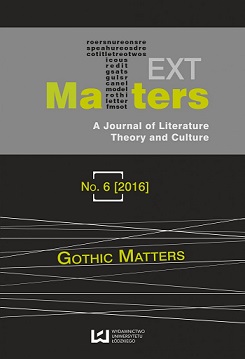The Monk by M. G. Lewis: Revolution, Religion and the Female Body
DOI:
https://doi.org/10.1515/texmat-2016-0002Abstract
This paper reads The Monk by M. G. Lewis in the context of the literary and visual responses to the French Revolution, suggesting that its digestion of the horrors across the Channel is exhibited especially in its depictions of women. Lewis plays with public and domestic representations of femininity, steeped in social expectation and a rich cultural and religious imaginary. The novel’s ambivalence in the representation of femininity draws on the one hand on Catholic symbolism, especially its depictions of the Madonna and the virgin saints, and on the other, on the way the revolutionaries used the body of the queen, Marie Antoinette, to portray the corruption of the royal family. The Monk fictionalizes the ways in which the female body was exposed, both by the Church and by the Revolution, and appropriated to become a highly politicized entity, a tool in ideological argumentation.
Downloads
References
Arcand, Bernard. The Jaguar and the Anteater: Pornography Degree Zero. Trans. Wayne Grady. London: Verso, 1993. Print
Google Scholar
Bakhtin, Mikhail. Rabelais and His World. Trans. Hélène Iswolsky. Bloomington: Indiana UP, 1984. Print.
Google Scholar
Bridge, James. “Lucy, Saint.” The Catholic Encyclopedia. Vol. IX. New York: Robert Appleton, 1910. 414–15. Hathi Trust Digital Library. Web. 4 Nov. 2014.
Google Scholar
Burke, Edmund. [1757] A Philosophical Enquiry into the Origins of Our Ideas of the Sublime and the Beautiful. Extracts. The Gothic Novel: A Casebook. Ed. Victor Sage. London: Macmillan. 1994. 33–38. Print.
Google Scholar
Burke, Edmund. [1790] Reflections on the French Revolution & Other Essays. London: Dent, 1951. Print.
Google Scholar
Clugnet, Leon. “Catherine of Alexandria, Saint.” The Catholic Encyclopedia. Vol. III. New York: Robert Appleton, 1908. 445–46. Hathi Trust Digital Library. Web. 4 Nov. 2014.
Google Scholar
Colley, Linda. Britons: Forging the Nation 1707–1837. New Haven: Yale UP, 2012. Print.
Google Scholar
Davenport-Hines, Richard. Gothic: Four Hundred Years of Excess, Horror, Evil and Ruin. New York: North Point, 2000. Print.
Google Scholar
Harvie, Christopher. “Revolution and the Rule of Law (1789–1851).” The Oxford Illustrated History of Britain. Ed. Kenneth O. Morgan. London: BCA, 1993. 419–62. Print.
Google Scholar
Kilgour, Maggie. The Rise of the Gothic Novel. London: Routledge, 1997. Print.
Google Scholar
Kromm, Jane. “Representations of Revolutionary Women in Political Caricature.” The French Revolution Debate in English Literature and Culture. Ed. Lisa Plummer Crafton. Westport, CT: Greenwood, 1997. 123–35. Print.
Google Scholar
Lewis, Matthew Gregory. [1796] The Monk. Oxford: Oxford UP, 1998. Print.
Google Scholar
MacErlean, Andrew A. “Genevieve, Saint.” The Catholic Encyclopedia. Vol. VI. New York: Appleton, 1908. 413–15. Hathi Trust Digital Library. Web. 4 Nov. 2014.
Google Scholar
McEvoy, Emma. Introduction. The Monk. By M. G. Lewis. Oxford: Oxford UP, 1998. vii-xxxiv. Print.
Google Scholar
Paulson, Ronald. Representations of Revolution (1789–1820). New Haven: Yale UP, 1983. Print.
Google Scholar
Porter, Roy. Bodies Politic. Disease, Death and Doctors in Britain, 1650-1900. Ithaca, NY: Cornell UP, 2001. Print.
Google Scholar
Punter, David. The Literature of Terror: A History of Gothic Fictions from 1765 to the Present Day. Vol. 1: The Gothic Tradition. New York: Longman, 1996. Print.
Google Scholar
Robinson, Paschal. “Clare of Assisi, Saint.” The Catholic Encyclopedia. Vol. IV. New York: Robert Appleton, 1908. 4–6. Hathi Trust Digital Library. Web. 4 Nov. 2014.
Google Scholar
Sade, Marquis de. [1800] Les Crimes de l’Amour. Extract. The Gothic Novel: A Casebook. Trans. and ed. Victor Sage. London: Macmillan, 1994. 48–49. Print.
Google Scholar
Schama, Simon. Citizens: A Chronicle of the French Revolution. London: Penguin, 1989. Print.
Google Scholar
Spooner, Catherine. Fashioning Gothic Bodies. Manchester: Manchester UP, 2004. Print.
Google Scholar
“Terrorist System of Novel Writing.” Anon. Monthly Magazine vol. IV (1797): 102–04. Hathi Trust Digital Library. Web. 4 Nov. 2014.
Google Scholar
Thomas, Luis-Vincent. Trup: od biologii do antropologii. Trans. Krzysztof Kocjan. Warszawa: Ethos, 2001. Print.
Google Scholar
Todd, Janet. Introduction. A Vindication of the Rights of Men. A Vindication of the Rights of Woman. An Historical and Moral View of the French Revolution. By Mary Wollstonecraft. Oxford: Oxford UP, 1999. vii-xxx. Print.
Google Scholar
Whitlark, James. “Heresy Hunting: The Monk and the French Revolution.” Romanticism on the Net 8 (November 1997). Web. 2 May 2002.
Google Scholar
Wollstonecraft, Mary. [1790] A Vindication of the Rights of Men. Oxford: Oxford UP. 1999. 1–62. Print.
Google Scholar
Wollstonecraft, Mary. [1794] An Historical and Moral View of the Origin and Progress of the French Revolution. Oxford: Oxford UP, 1999. 285–371. Print.
Google Scholar
Downloads
Published
How to Cite
Issue
Section
License

This work is licensed under a Creative Commons Attribution-NonCommercial-NoDerivatives 4.0 International License.













